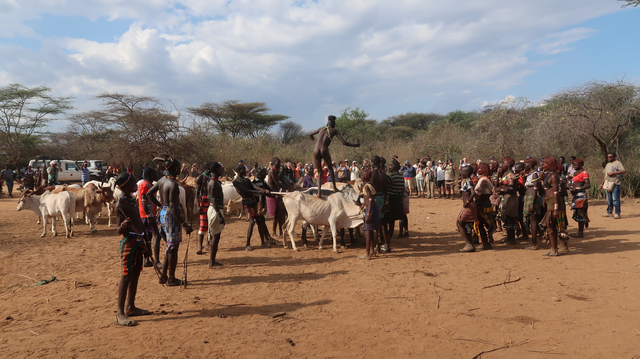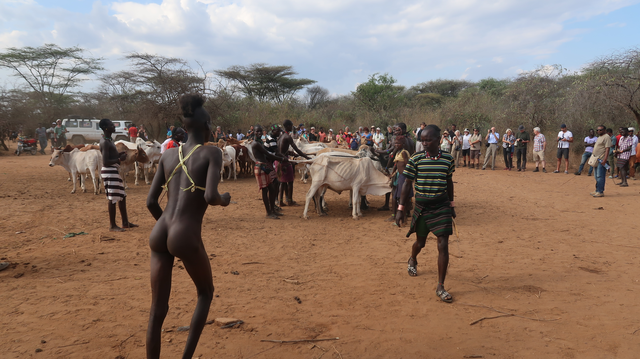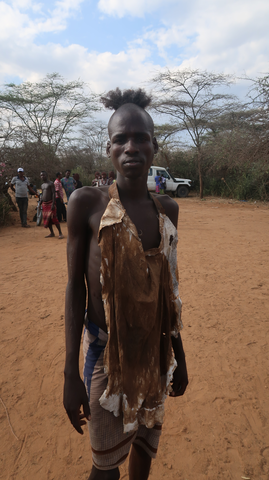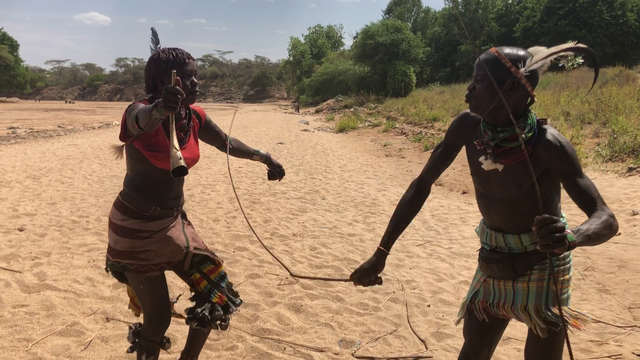Brief History of the Hamar Tribe
 The Hamar tribe is an Omotic community residing in South Western Ethiopia. They hail from the Omo river valley in the Debub Omo zone with villages in Turmi and Dimeka representing approximately 0.1% of the total Ethiopian population.
The Hamar tribe is an Omotic community residing in South Western Ethiopia. They hail from the Omo river valley in the Debub Omo zone with villages in Turmi and Dimeka representing approximately 0.1% of the total Ethiopian population.
With major activities ranging mostly from honey collection and rearing of cattle, the Hamar tribe are mostly Muslim shepherds, living in camps consisting of several families.
At night, the cattle are brought into the center of the circle until the early hours of the next day when it is time for grazing again.
This has been the tradition of the Hamar tribe for generations. It is a fascinating culture, as they do not believe in individual land ownership — it’s free for cultivation and grazing, same as fruits are free for whoever collects them.
The Bull Jumping Ceremony (Ukuli Bula) of the Hamar Tribe
This famous bull jumping ceremony of the Hamar tribe is the culmination of a three-day-long rite of passage for a young boy (Ukuli) transitioning into manhood.
The event is graced by most of the communities across the Omo valley in South Western Ethiopia and is aimed at putting the young boys’ valor and bravery to the test.
He must be able to conquer his fears and get through with the task in order for him to be considered a man.
This ritual is important because passing it qualifies him to own cattle, get married, and raise children.
 The bull jumping ceremony usually takes place in October or November and involves running across the backs of seven to ten castrated bulls four times without falling.
The bull jumping ceremony usually takes place in October or November and involves running across the backs of seven to ten castrated bulls four times without falling.
By tradition, the eldest child of the family must go through the bull jumping ceremony rite of passage before his younger ones can follow and it is the father that decides when his eldest son is ready.
The ceremony itself can be partaken by boys as young as five with the help of the community.
When the father decides his son is ready, he gives him a small phallic carved wood called “Boko”. The boy then hands it to the girls he meets along the way and they must kiss it three times as a form of blessing and then return it to him.
He then travels to all his relatives’ houses presenting the Boko given to him by his father and also invites them to the ceremony.
The timing of the ceremony is up to the parents of the young man and the decision is based on the amount of time it would take them to prepare the feast, which usually happens after the harvest.
As an invitation, the guests receive a strip of bark with a number of knots or a coil of rope marked to show the number of days leading to the ceremony. The invitees then cut a piece from the bark or rope every day to keep track of the days left before the bull jumping rites.
The Bull Jumping Ceremony Preparations
 Before the young man leaps over the cattle, he passes through a curious rite of passage — his head is partially shaved and his body rubbed with sand, as this is believed to wash away his sins.
Before the young man leaps over the cattle, he passes through a curious rite of passage — his head is partially shaved and his body rubbed with sand, as this is believed to wash away his sins.
He is also smeared with dung to give him strength, and strips of the bark of the tree are strapped around his body in a cross form for spiritual protection.
The castrated cattle in turn are also smeared with dung to make them slippery, usually about 7 to 10 castrated cows are lined up representing the women and children of the tribe.
If the man in question is lame or blind, he is helped across the cattle by others and must be through with this initiation right before he can be deemed fit to marry the woman chosen to him by his parents, and he can now start his own family and build his herd.
Bride price payments usually amount to about 36 goats and 20 cattle. A local alcoholic beverage made with sorghum is served to those who came to celebrate the Bar-mitzvah of the Hamer tribe.
Hamar women dressed in their traditional regalia are adorned with bells around their legs while they dance together and play their loud horns.
Initiating the Boy into Manhood
As sunset approaches, it is time for the young boy to be initiated through the ceremony and according to tradition, he is usually stripped naked before he attempts the leap.
With the blaring sounds of bells and horns in the air, the boy takes a leap usually four or five times across the castrated cattle demonstrating his agility, valor, and strength.
And if successful, he is then sent to the elders and Maza (young men who are still single and have recently done the bull jumping ceremony) who in turn bless him, shave his head and crowns him with the title Maza.
 But if the odds are against him, and he is unsuccessful, falling more than four times, he would have to wait for another year to try again.
But if the odds are against him, and he is unsuccessful, falling more than four times, he would have to wait for another year to try again.
Once successful, he becomes a man and animal skin is placed on his neck amid cheers from kinsmen and blowing of horns.
The kinsmen and neighbors relocate for a huge dance which usually continues until the early hours.
The Role of the Hamar Women
On the afternoon of the leap, women and young girls are whipped with a birch stick as part of the ritual ceremony.
The fierce women in this region are famous for their multitude of colorful beads, polished iron jewelry and numerous piercings that adorn their bodies.
This is an intriguing, yet somewhat brutal process, since the women do ask to be whipped on their backs and the men oblige, scarring their skins with each stroke.
 It is believed the greater the pain, the higher the level of submission and loyalty they are showing to the Maza, and the scars left on their bodies are a symbol of the loyalty they are to receive in turn from him.
It is believed the greater the pain, the higher the level of submission and loyalty they are showing to the Maza, and the scars left on their bodies are a symbol of the loyalty they are to receive in turn from him.
The idea is that at some point in the future, the girls may need the young man’s help and show him their scars, as if obligating him to provide the requested assistance. This makes the ceremony and the tribe truly unique.
The bull jumping ceremony ends with several days of feasting, typical jumping dances accompanied by sorghum made beer and coffee which the Ukili’s family provides to the guests.
If you ever go to Ethiopia do not miss this unique event! The good part is that you will be allowed to take as many pictures as you may want without being asked to pay and it’s just a great way to experience a new culture firsthand.
Watch our client’s first-hand experience of witnessing this tradition.
Experience Ethiopia’s amazing culture! Check out our top 3 culture tours here:
12 Days Discover Tribal Ethiopia
6 Days Omo Valley Highlights
16 Days Omo Valley, Awash Park, and Harar










